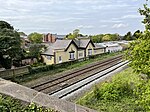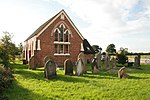Newton-by-Tattenhall
Cheshire West and ChesterCheshire geography stubsFormer civil parishes in CheshireVillages in Cheshire

Newton is a settlement and as Newton-by-Tattenhall a former civil parish, now in the parish of Tattenhall and District in the Cheshire West and Chester district, and ceremonial county of Cheshire in England. In 2011 it had a population of 131, up from 116 in 2001. The civil parish was abolished in 2015 to form Tattenhall and District, part also went to Hargrave and Huxley.
Excerpt from the Wikipedia article Newton-by-Tattenhall (License: CC BY-SA 3.0, Authors, Images).Newton-by-Tattenhall
Newton Lane, Chester Tattenhall and District
Geographical coordinates (GPS) Address Nearby Places Show on map
Geographical coordinates (GPS)
| Latitude | Longitude |
|---|---|
| N 53.133 ° | E -2.753 ° |
Address
Newton Lane
Newton Lane
CH3 9ND Chester, Tattenhall and District
England, United Kingdom
Open on Google Maps







